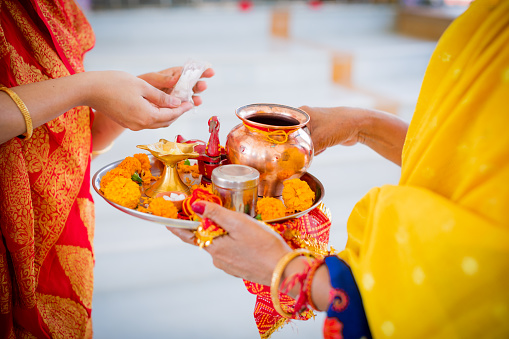Navaratri is among the most important Hindu festivals that celebrate the nine forms of Goddess Durga. The celebrated Durga is the goddess of courage and power in the Hindu pantheon. As the name “Navaratri” suggests, the celebration lasts for nine days dedicating each day to the multiple powers and forms of the Goddess. Different communities and cultures have their own way to celebrate this important occasion as the colours of autumn flourish in India.
As you decorate your homes each Navaratri, your homes are filled with a variety of vibrant colours. Each of these shades has a unique significance with respect to Goddess Durga. Revamping your homes this Navaratri, take a look at how these colours can affect your moods along with understanding their cultural significance!

Day 1 (Pratipada): Yellow
This is the first day of Navaratri and yellow is a beautiful colour to denote happy beginnings. It is also the colour of the first incarnation of Durga, Shailaputri or “the Daughter of the Mountains”. The goddess denotes the powerful and raw form of Mother Nature, symbolizing abundance and grace. Yellow is a bright, cheerful colour that is perfect to denote any celebration.
Day 2 (Dwitiya): Green
The second day is dedicated to Brahmacharani which means “the seeker of knowledge”. This day signifies how Parvati climbs the harsh mountains to do penance in order to get spiritual knowledge. The tough act of acquiring knowledge is very relatable and inspiring for young learners and students. Green denotes peace and prosperity on acquiring true knowledge of the world.
Day 3 (Tritiya): Grey
Grey is the colour of the Goddess Chandragantha. She is denoted with a half-moon on her forehead. This represents the Third Eye that is always open to stay alert to fight against demons. The Third Eye also represents great knowledge with which comes great responsibility. Grey denotes the calmness of the moon but also the importance of maintaining balance in the universe.
Day 4 (Chaturthi): Orange
The fourth day is dedicated to Goddess Kushmanda. This form symbolizes the cosmic energy and warmth of the sun. Orange is the perfect colour to denote the luminosity of the goddess and her exuding energy. She bestows wealth and strength to her worshippers. Kushmanda is also known for her divine smell. According to myths, she created the universe (Brahmanda) by just flashing a smile. Orange also denotes the change of seasons in autumn.

Day 5 (Panchami): White
The fifth day is to celebrate Skandamata, the mother of Skanda or Kartikeya (The God of War). The Goddess is observed riding on a lion or sitting on a lotus (Padamasani). White denotes the purity of a mother’s love and her extreme patience. White also symbolizes the prayers of the devotees of the Goddess. She rewards her devotees with salvation and oceans of wisdom.
Day 6 (Shashti): Red
Katyayani is the sixth incarnation of Goddess Durga. She is the fiercest form of the Devi and her colour red denotes her extreme anger and power against the demon, Mahishasura. Mounted on a lion, the Goddess denotes the power of action and vigour. Red rightfully adorns and represents this form as the best colour of power and energy.
Day 7 (Saptami): Royal Blue
The seventh incarnation of the Devi is Kalaratri. Popularly known as Kali and Chandi, this is a most destructive form of the Goddess. Blue denotes the colour of the night. The appearance of Kalaratri invokes fear among all evil spirits and ghosts. Therefore, the Goddess is known to remove all dark and negative energy from your home. Kalaratri has many references in Hindu mythology in multiple other forms as well.
Day 8 (Asthami): Pink
The penultimate day of the Navaratri is devoted to Mahagauri. She is depicted riding a white bull and carries her blessings everywhere. This is the form that fulfils all the desires of the devotees. The colours pink denotes a new, fresh perspective. Pink also denotes hope and a new life for everyone.
Day 9 (Navami): Purple
The ninth form of Durga is Siddhidhatri, meaning ‘the giver of supernatural powers’. The goddess fulfils all the aspirations and ambitions of worshippers, giving them knowledge and the ability to conquer any worldly challenge. According to the myths, Lord Shiva acquired all his powers by worshipping Siddhidhatri. Purple is a royal colour that rightfully represents ambition, creativity, and power for the devotees.

Understanding the nine forms of Durga (Navadurga) can help understand this festival deeply. By knowing the significance of each colour, you can use them properly to spread the positive energy of the festival. Apply these colours to decorate your homes and spread the divine energy of Goddess Durga.
